List of Contents
What is Intragastric Balloon Market Size?
The global intragastric balloon market size is valued at USD 53.69 million in 2025 and is anticipated to reach around USD 117.99 million by 2034, expanding at a CAGR of 9.15% from 2025 to 2034. The increasing acceptance and endorsement of intragastric balloons by regulatory bodies across different areas is shown in the regulatory approvals for these devices, which instills confidence in patients and healthcare professionals.
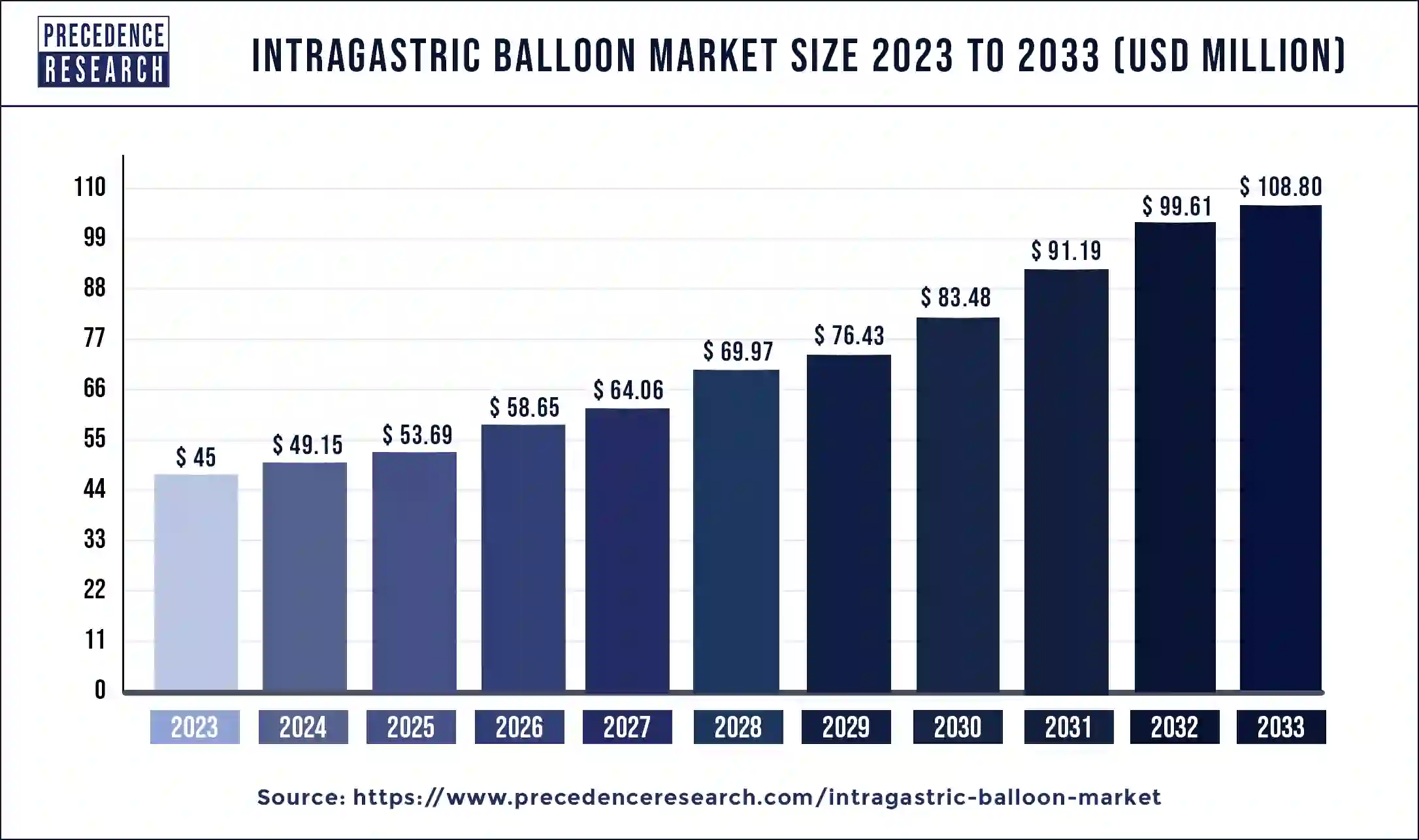
Market Highlights
- By region, North America held the largest share of the intragastric balloon market in 2024 with 38.4%.
- By region, Asia Pacific is expected to witness significant growth during the forecast period.
- By balloon type, in 2023, the single segment held the largest share of 66%.
- By filling material, the saline filled segment held the dominant share of around 73% in 2024.
- By administration, the endoscopy segment held the largest share of over 72.3% in 2024.
- By end use, the hospitals segment has accounted market share of around 55% in 2024.
Intragastric Balloon Market Overview
With obesity rates rising globally and people's choice for less invasive weight loss methods, the intragastric balloon industry was growing steadily. Non-surgical intragastric balloons are inserted into the stomach to increase feelings of fullness and decrease food intake, which in turn helps with weight loss. Due to its link to a number of chronic illnesses, including diabetes, cardiovascular disease, and several types of cancer, obesity has emerged as a major global health concern. Consequently, there has been a rise in the need for efficient weight reduction methods.
When considering weight loss procedures, intragastric balloon insertion is less invasive than standard methods such as gastric bypass or sleeve gastrectomy. Therefore, it is a recommended choice for people looking for weight loss procedures with lower risks and complications. Technological developments in intragastric balloons have resulted in the creation of safer and more effective devices. Better results and patient comfort are provided by more recent balloons with enhanced materials and designs.
A growing number of people are investigating options such as intragastric balloons as a result of increased knowledge about the health hazards linked to obesity and the availability of various weight loss methods. Many nations' regulatory agencies have been in favor of intragastric balloon treatments, which has allowed the industry to flourish by guaranteeing that safety and efficacy requirements are met. The intragastric balloon market is subject to various factors that could impact its current state, including changes in consumer preferences, rising rivals, regulatory changes, and technological breakthroughs.
Growth Factors
- The global increase in obesity rates has been a primary factor propelling the intragastric balloon market's expansion. Intragastric balloons are one of the less intrusive weight loss options that are in greater demand as obesity rates rise, especially in wealthy nations.
- Because non-surgical weight loss techniques have less dangers, require shorter recovery periods, and are less invasive than standard bariatric surgery, many people choose them over the latter. Because they provide a viable non-surgical weight loss option, intragastric balloons are becoming more and more popular among patients and medical professionals.
- The general public's and healthcare professionals' growing awareness of intragastric balloon availability and advantages has fueled intragastric balloon market expansion. Intragastric balloons are becoming more widely accepted as a practical weight loss option as more information becomes available through medical research, educational initiatives, and media coverage.
- Global healthcare spending is increasing, making elective treatments such as intragastric balloon implantation more affordable for a greater number of people. Furthermore, several nations have altered their funding regulations for weight loss procedures, such as intragastric balloons, opening up access to a larger range of patients.
- Health and wellness are becoming increasingly important in today's society, and many people are looking for proactive ways to control their weight and general health. This trend is supported by intragastric balloons, which provide a non-invasive, short-term weight loss treatment that draws people who are driven to alter their lifestyles.
Recent Trends
- Growing preference for non-surgical, safe weight-loss options. Rising obesity rates and demand for quick recovery drive this trend.
- Launch of advanced swallowable and adjustable balloons. These innovations improve comfort and reduce the need for endoscopy.
- Shift toward endoscopic and minimally invasive procedures. Patients prefer faster, less painful treatments with minimal downtime.
- Rapid adoption in Asia-Pacific and Latin America. Increasing medical tourism and affordability are fueling market growth.
- Focus on long-term results and improved reimbursement.Companies are developing programs to support sustained weight management.
Market Outlook
- Industry Growth Overview: The intragastric balloon market is growing as more individuals seek out non-surgical ways to lose weight. The purpose of these balloons is to increase the feeling of fullness and decrease food intake. Rising obesity rates increased knowledge of minimally invasive therapies, and improvements in device design are driving up demand.
- Sustainability Trends: In this market, the emphasis is on offering treatments that are widely available, safe, and effective. Improved safety features, adjustable volume balloons, and balloonable capsule balloons are examples of innovations. Less invasive outpatient procedures with quicker recovery times are the trend. To guarantee long-term weight loss, many providers incorporate balloons into more comprehensive diet and lifestyle plans. As healthcare infrastructure advances, emerging markets are also embracing these solutions more quickly.
- Global Expansion: Global market growth is occurring. North America is in the lead because of its well-established healthcare systems and a high rate of obesity. Growing obesity, increased awareness, and improved access to healthcare are driving rapid growth in the Asia Pacific and other developing regions. To reach a larger patient base, businesses are looking into new markets, collaborations, and medical tourism opportunities.
Intragastric Balloon Market Scope
| Report Coverage | Details |
| Global Market Size in 2025 | USD 53.69 Million |
| Global Market Size in 2026 | USD 58.65 Million |
| Global Market Size by 2034 | USD 117.99 Million |
| Growth Rate from 2025 to 2034 | CAGR of 9.15% |
| Largest Market | North America |
| Base Year | 2024 |
| Forecast Period | 2025 to 2034 |
| Segments Covered | By Balloon Type, By Filling Material, By Administration, and By End-use, and region |
| Regions Covered | North America, Europe, Asia-Pacific, Latin America, and Middle East & Africa |
Intragastric Balloon Market Dynamics
Driver: Increasing obesity rates
As obesity rates rise, there may be a greater need for weight loss treatments, such as intragastric balloons, as individuals look for practical ways to control their weight and associated health problems. Increased demand could spur technological innovation and developments in the intragastric balloon market, resulting in the creation of safer and more effective balloon designs and materials.
A wider range of people may be able to afford and obtain intragastric balloons as the intragastric balloon market grows, taking into account the socioeconomic aspects that contribute to obesity. Increased public knowledge of non-surgical weight loss methods, such as intragastric balloons, may result from rising obesity rates, which may encourage healthcare professionals to inform patients about these options.
Restraint: Cost and insurance coverage
Pre-operative examinations, follow-up treatment, anesthetic expenses, surgeon fees, hospital or facility fees, and the cost of the balloon itself are some of the typical costs associated with an intragastric balloon surgery. Patients should also take into account any possible costs that they might incur out of cash, such as co-insurance, deductibles, and co-payments, even if their insurance covers the surgery.
There are major differences in insurance coverage for intragastric balloon treatments. When a procedure is considered medically necessary, insurance companies may pay for it. This is often the case for people with high body mass index (BMI) who have not responded well to conventional weight loss techniques and who have associated medical issues like diabetes or hypertension. It can be necessary to get pre-authorization from the insurance company even if coverage is available.
Opportunity: Patient-centric approach
Intragastric balloon manufacturers are placing a greater emphasis on creating devices that minimize adverse effects, promote patient comfort, and are simple to insert. This involves minimizing discomfort and improving tolerability through improvements in balloon materials, forms, and sizes. Patients receiving intragastric balloon treatment are increasingly being offered extensive support services in addition to the device.
It is essential to teach patients about intragastric balloon therapy's advantages, disadvantages, and anticipated results in order to promote treatment adherence and well-informed decision-making. The intragastric balloon devices can be made to better fulfill patients' expectations and real-world demands by working with patient advocacy groups and incorporating patient feedback into product development and marketing strategies.
Segment Insights
Balloon Type Insights
The single segment held the largest share of the intragastric balloon market. An intragastric balloon device that only has one balloon falls into a particular category or type, which is referred to as a single balloon type segment. These devices, which are intended to be endoscopically put into the stomach and filled with gas or saline to take up space, are used to treat obesity. This contributes to the sensation of fullness, which lowers food intake and promotes weight loss.
The sector for a particular balloon type may contain a range of goods from distinct producers, each with unique features, sizes, compositions, and designs. To help people lose weight, these balloons—which are typically only meant to be worn temporarily before needing to be taken down—can be utilized in conjunction with dietary and lifestyle changes.
The triple segment is expected to witness significant growth during the forecast period. The acceptance and success of products in this market are influenced by variables such as patient tolerance, safety, effectiveness, ease of insertion and removal, and regulatory approval status.
Furthermore, continued research and development initiatives might result in technological breakthroughs for balloons, which might increase the range of products available in the intragastric balloon market's triple balloon type segment. Other intragastric balloon market segments could include double balloon systems, other balloon designs, and alternative building materials like silicone or other biocompatible materials.
Filling Material Insights
The saline filled segment held the dominant share of the intragastric balloon market in 2024. One of the main kinds of intragastric balloons used in weight loss operations is saline-filled balloons. Once inserted into the stomach, these balloons are usually filled with saline solution. This occupies space in the stomach and causes a feeling of fullness, which reduces food intake and aids in weight loss.
The ability of intragastric balloons to effectively encourage weight loss and support the management of obesity is a major factor propelling market expansion. The successful market adoption of saline-filled balloons is largely dependent on clinical research and empirical data. It is crucial to guarantee the safety of intragastric balloon treatments. Developments are meant to lessen unfavorable outcomes related to balloon insertion and aid in market growth. Producers make investments in creating balloons with enhanced safety features.
For intragastric balloon market participants, adherence to regulatory obligations is crucial. The commercialization of saline-filled intragastric balloons requires approvals from regulatory bodies such as the FDA (Food and Drug Administration) in the United States and CE marking in Europe. There is fierce competition among the players in the intragastric balloon market as they compete for market share. For businesses in this industry, competing on elements like product effectiveness, pricing, and after-sales service is essential. Expanding the market requires educating patients and medical professionals about the advantages and disadvantages of intragastric balloon therapy. Saline-filled balloon demand may be driven by growing knowledge of intragastric balloons and obesity therapy options.
Administration Insights
The endoscopy segment held the largest share of the balloon market in 2024. Compared to surgical operations, endoscopic techniques are considered to be less intrusive when it comes to placing intragastric balloons. The balloon can usually be inserted endoscopically, which reduces the chance of problems and downtime and is, therefore, a desirable alternative for physicians and patients alike.
Endoscopic procedures provide patients with a less intrusive option for surgery, which can lead to a decreased risk of postoperative complications, faster recovery times, and less discomfort. The increased use of intragastric balloons as a therapy option for obesity and associated comorbidities is partly due to the better patient experience. The insertion of intragastric balloons can now be done in a safer and more effective manner thanks to developments in endoscopic technology.
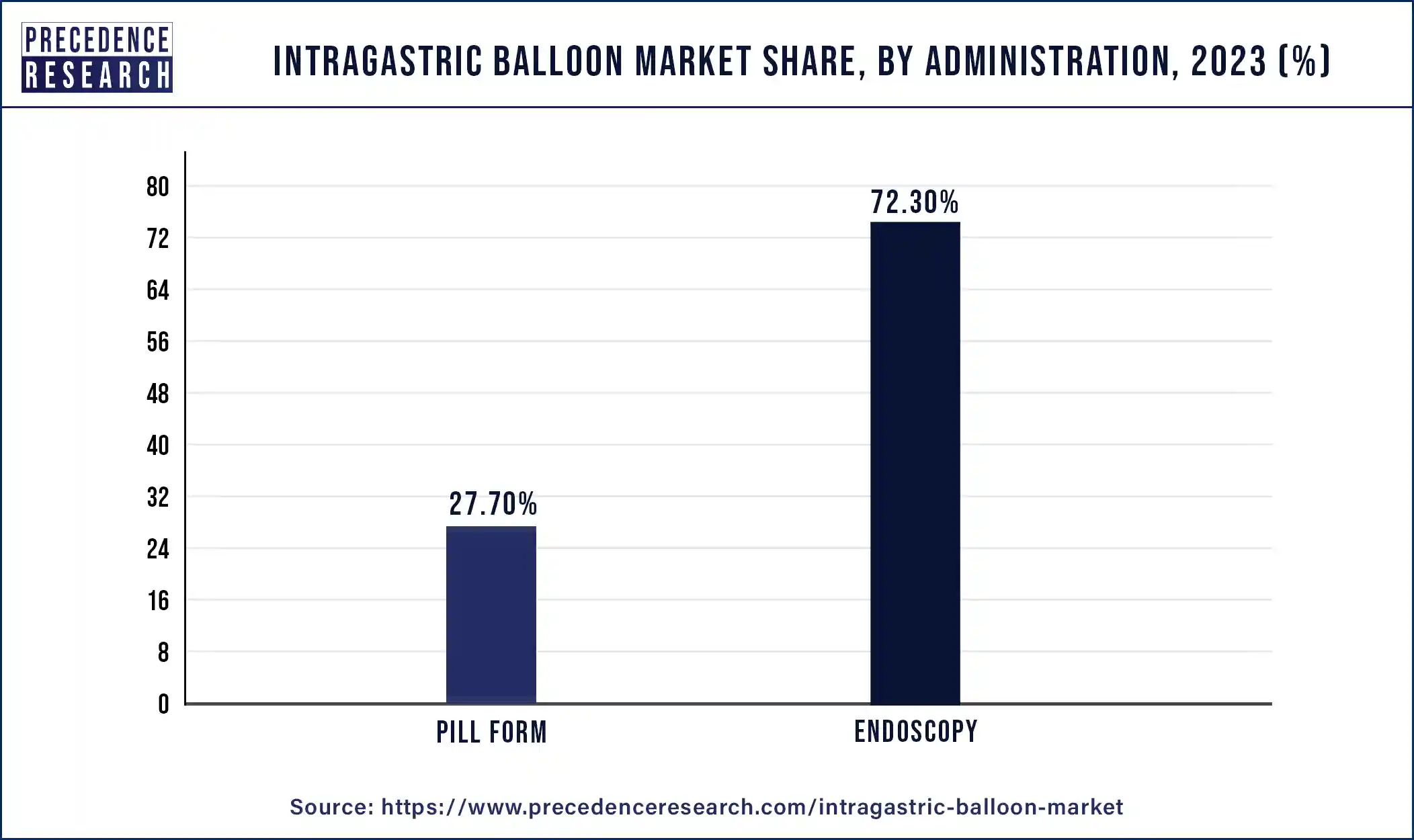
In order to prioritize patient safety, endoscopic procedures for intragastric balloon implantation have evolved. For example, using intragastric balloons with integrated safety features, including anti-migration mechanisms and biocompatible materials, lowers the possibility of unfavorable outcomes and guarantees the procedure's overall safety. By precisely placing and removing intragastric balloons, endoscopy lowers the risk of problems and guarantees the best possible outcome for patients. During the insertion and removal processes, medical professionals may see the stomach in real time, enabling them to make any necessary modifications. Compared to standard surgical techniques, endoscopic operations are less invasive, which means that patients experience fewer complications and quicker recovery times.
End Use Insights
The hospital segment dominated the intragastric balloon market in 2024. The use of intragastric balloons (IGBs) for weight reduction procedures in hospital settings is referred to as the hospital segment in the intragastric balloon market. By taking up room in the stomach, increasing satiety, and decreasing food intake, intragastric balloons are a minimally invasive weight reduction therapy option that can assist people in losing a considerable amount of weight.
Intragastric balloon treatments are usually carried out in hospital settings in specialist endoscopy suites or operating rooms by medical professionals with training in bariatric surgery or gastroenterology. In the hospital setting, patients having intragastric balloon implantation frequently receive thorough pre-procedural assessments, counseling, and post-procedural care.
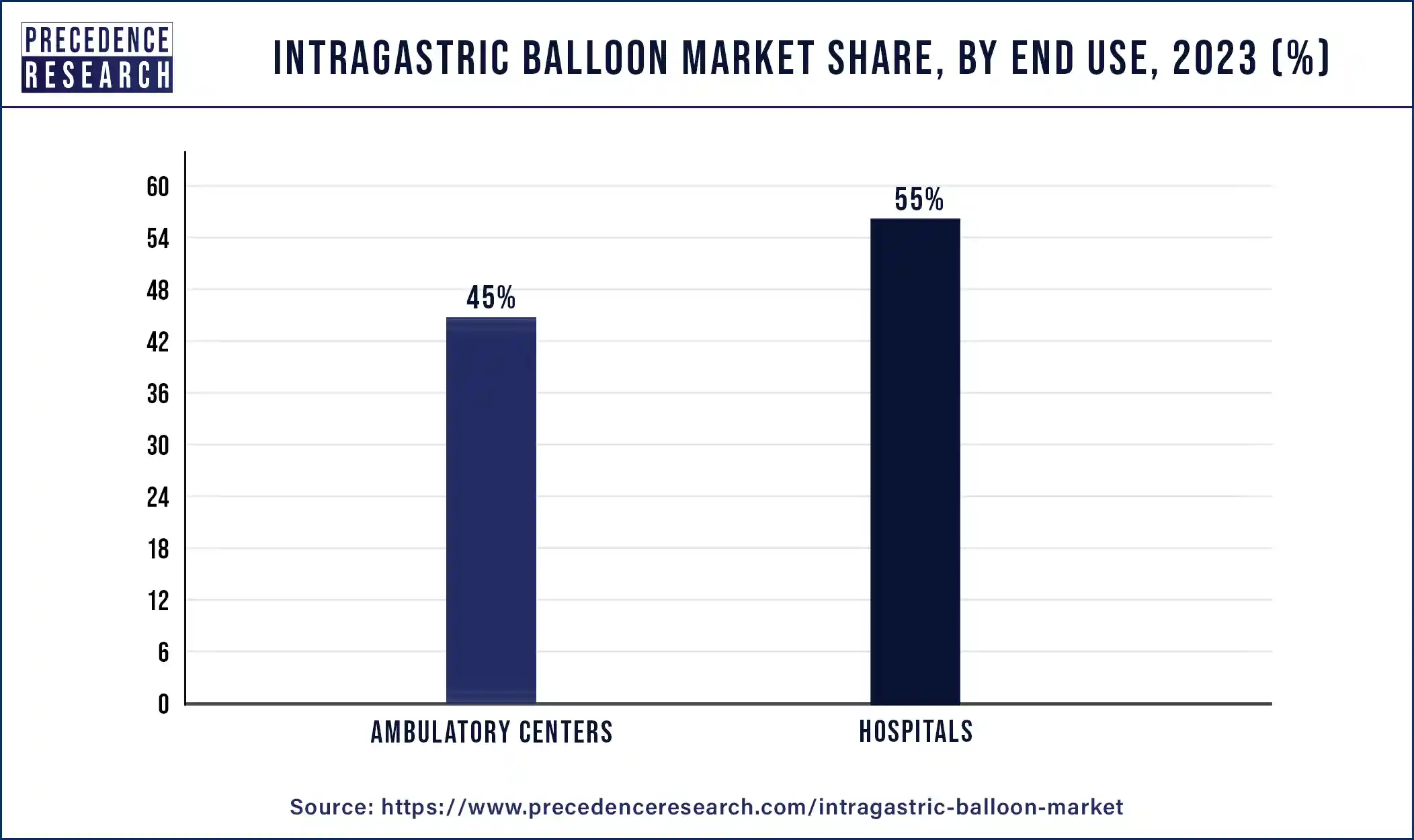
Hospitals usually have the specific tools, spaces, and qualified medical personnel needed to carry out intragastric balloon treatments in a secure and efficient manner. Comprehensive care routes, such as pre-procedural evaluation, nutritional counseling, follow-up visits, and management of any problems, are frequently provided by hospital-based weight reduction programs. By following strict safety guidelines and regulations, hospitals give patients peace of mind and trust when they undergo intragastric balloon treatments. Patients seeking weight loss therapies are frequently referred to hospitals by primary care physicians, dietitians, and other healthcare professionals. For individuals who qualify, hospital-based intragastric balloon operations may be a more accessible choice since they may be more likely to be funded by health insurance plans in some areas.
Regional Insights
Intragastric Balloon Market Size in U.S. 2025 to 2034
The U.S. intragastric balloon market size is estimated at USD 16.70 million in 2025 and is projected to surpass around USD 36.7 million by 2034 at a CAGR of 10.12% from 2025 to 2034.
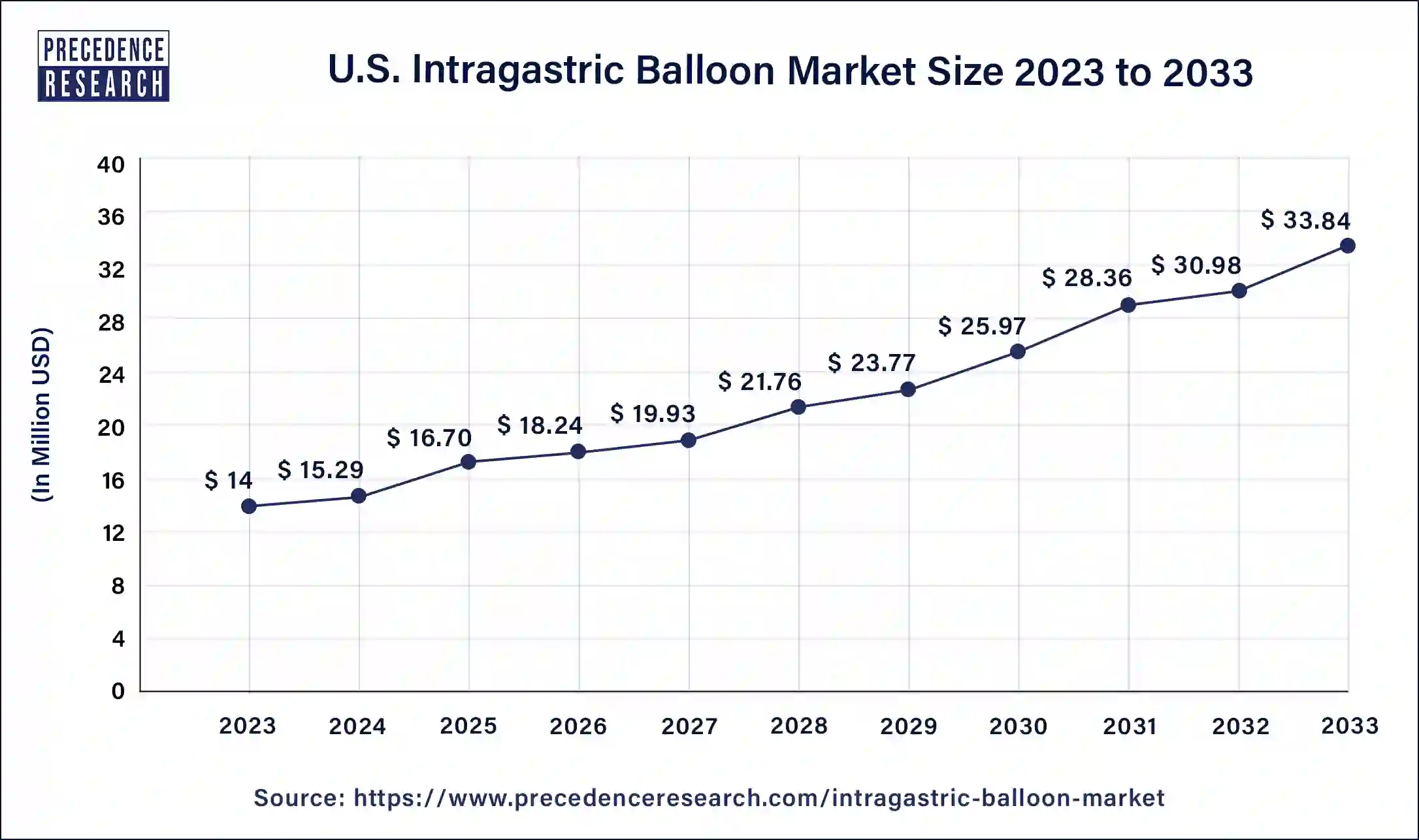
North America holds the largest share of the intragastric balloon market. Non-surgical weight loss devices called intragastric balloons are inserted into the stomach to help people feel fuller and eat less. Growing obesity rates, increased understanding of the value of weight control, and improvements in medical technology that make these operations safer and more widely available are some of the drivers driving this industry. Because of its well-established healthcare system and high obesity incidence, the United States has been the largest market for intragastric balloons in North America. Though not as much as the U.S., Canada nevertheless makes a contribution to the market.
Asia Pacific is also expected to hold the largest share of the intragastric balloon market during the forecast period. Due to shifting food choices, urbanization, and lifestyle changes, obesity rates were significantly rising in nations like China, India, and Indonesia. The desire for efficient weight loss methods was being driven by this demographic shift. Healthcare providers and patients in the area were becoming more aware of the dangers associated with obesity and the availability of less intrusive weight loss techniques like intragastric balloons.
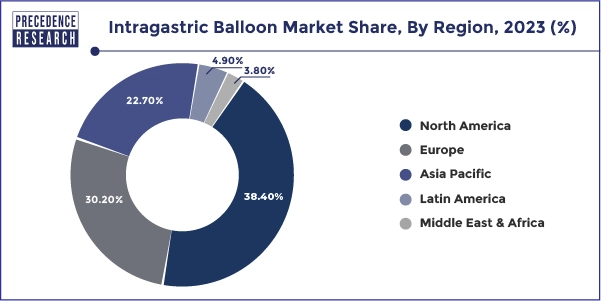
More people were able to access cutting-edge medical treatments, such as intragastric balloon procedures, thanks to rising healthcare spending in Asia Pacific's expanding nations. Patients from other nations were being drawn to the region for intragastric balloon treatments due to the accessibility of reasonably priced healthcare services and the standing of certain nations as medical tourism destinations.
Value Chain Analysis
- R&D
This stage involves designing new intragastric balloon devices, improving materials, enhancing delivery systems, and developing safer, more effective solutions. Companies like Allurion Technologies and Apollo Endosurgery focus on innovation to improve patient comfort, durability, and ease of placement. R&D also explores adjustable balloons, swallowable systems, and integration with digital health monitoring tools. - Clinical Trials & Regulatory Approvals
Before market entry, intragastric balloons undergo clinical trials to evaluate safety, efficacy, and tolerability. Regulatory approvals from agencies like the FDA or CE marking in Europe are critical. Key players managing this stage include ReShape Lifesciences and Spatz FGIA, who work closely with hospitals and research centers to meet international standards. - Patient Support & Services
After deployment, companies provide patient follow-up, removal/replacement services, nutritional guidance, and training for clinicians. Companies like Allurion Technologies and ReShape Lifesciences maintain support programs to ensure compliance, safety, and improved weight-loss outcomes. These services also include monitoring outcomes and updating protocols for newer balloon models.
Recent Developments
- In July 2025, ReShape Lifesciences announced that the USPTO would issue U.S. Patent No. 12,350,179 on 8 July 2025, covering its intragastric balloon system with a self‑sealing fill valve and degradable release valve designed to naturally excrete after deflation.(Source: https://ir.reshapelifesciences.com)
- In March 2024, ReShape Lifesciences received a Notice of Allowance from the USPTO for a patent application covering a swallowable intragastric balloon system comprising a capsule and a degradable release valve.(Source: https://www.globenewswire.com)
Intragastric Balloon Market Companies
- Allurion Technologies
- Allergan (Acquired by Abbott)
- Apollo Endosurgery
- Reshape Medical
- Spatz FGIA
- Endalis
- Silimed
- Medsil
Segment Covered in the Report
By Balloon Type
- Single
- Dual
- Triple
By Filling Material
- Saline Filled
- Gas Filled
By Administration
- Endoscopy
- Pill Form
By End-use
- Hospitals
- Ambulatory Centers
By Region
- North America
- Europe
- Asia-Pacific
- Latin America
- Middle East and Africa
For inquiries regarding discounts, bulk purchases, or customization requests, please contact us at sales@precedenceresearch.com
Frequently Asked Questions
Ask For Sample
No cookie-cutter, only authentic analysis – take the 1st step to become a Precedence Research client


